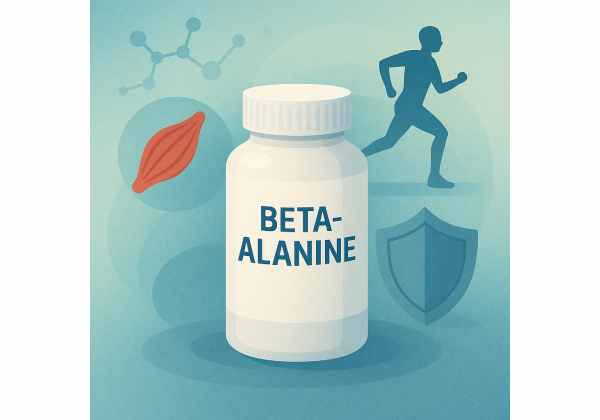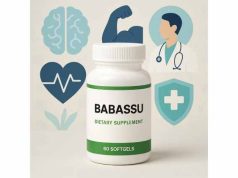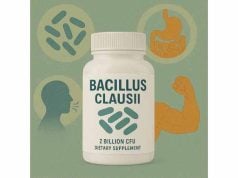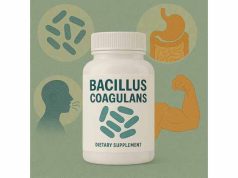
Beta-alanine is a naturally occurring amino acid and one of the most researched performance supplements for athletes and fitness enthusiasts. Known for its unique ability to increase muscle carnosine levels, beta-alanine acts as a buffer against acid build-up during intense exercise. This translates to improved muscular endurance, reduced fatigue, and the potential to train harder for longer periods. Beta-alanine is widely used in sports nutrition, pre-workout formulas, and by individuals aiming to boost performance in high-intensity activities such as sprinting, weightlifting, and team sports. In this comprehensive guide, you’ll learn how beta-alanine works, its key benefits, optimal dosing, safety considerations, and who can benefit most from its use.
Key Takeaways
- Enhances muscular endurance by increasing carnosine, which buffers lactic acid in muscles.
- Ideal for high-intensity training such as HIIT, weightlifting, and sprinting, improving exercise performance and delay of muscle fatigue.
- Tingling sensation (paresthesia) is a common, harmless side effect, especially with higher doses.
- Requires daily, consistent use for optimal results—benefits are not immediate.
- Proven safe for most healthy adults, but dosing and timing strategies can help minimize side effects.
Table of Contents
- Beta-Alanine Supplement Basics and Performance Roles
- The Science Behind Beta-Alanine: How It Works in the Body
- Beta-Alanine Benefits for Athletes and Real-World Uses
- Beta-Alanine Safety, Tolerability, Side Effects, and Interactions
- How to Take Beta-Alanine: Dosage, Timing, and Administration Tips
- Frequently Asked Questions About Beta-Alanine
Beta-Alanine Supplement Basics and Performance Roles
Beta-alanine is a non-essential amino acid, which means the body can produce it naturally, and it’s also found in foods like poultry and fish. However, the amount you get from diet alone is usually too low to significantly impact exercise performance. As a supplement, beta-alanine has become a staple in the fitness world due to its proven ability to enhance muscular endurance, making it especially popular among athletes who perform repeated bouts of high-intensity effort.
How Beta-Alanine Works in the Body
Beta-alanine’s key function is to raise muscle levels of carnosine—a dipeptide (two-amino-acid molecule) formed when beta-alanine combines with histidine in muscle tissue. Carnosine acts as an “acid buffer” inside muscle cells, neutralizing the hydrogen ions (H+) that accumulate during intense exercise and cause the burning sensation associated with fatigue.
By increasing carnosine stores, beta-alanine supplementation helps delay the drop in pH that contributes to muscle failure. This allows athletes to sustain high-intensity efforts for longer and complete more repetitions, sprints, or rounds before reaching exhaustion.
Why Is Carnosine Important?
- Buffering capacity: Carnosine soaks up excess acid, maintaining a favorable environment for muscle contractions.
- Delaying fatigue: With less acid build-up, muscles perform at high levels for longer, boosting overall work capacity.
Who Uses Beta-Alanine?
- Athletes and fitness enthusiasts: Especially those engaged in activities lasting 1–4 minutes, such as 400-800m sprints, rowing, CrossFit, team sports, and circuit training.
- Strength and power athletes: Including weightlifters, bodybuilders, and anyone performing repeated sets at near-maximum effort.
- Recreational exercisers: Looking to enhance endurance or training intensity.
Key Forms and Supplement Types
- Powder: Most common; easily mixed into water or pre-workout shakes.
- Capsules/tablets: For those who prefer convenience and precise dosing.
- Pre-workout blends: Beta-alanine is frequently included with caffeine, creatine, and other performance enhancers.
Notable Supplement Facts
- Not a direct stimulant: Beta-alanine does not increase energy or alertness like caffeine, but enhances muscular work output through different mechanisms.
- Requires daily loading: Unlike caffeine or creatine, the effects of beta-alanine build up over time as carnosine accumulates in muscle tissue.
Beta-Alanine in Foods
While you do get some beta-alanine from consuming meat and fish, the levels are not sufficient for ergogenic (performance-enhancing) effects. Vegetarian or vegan athletes are more likely to have lower carnosine levels and may see greater benefits from supplementation.
Summary of Why Beta-Alanine Matters
Beta-alanine fills a unique niche in the supplement world. It is the gold standard for boosting muscular endurance in short, high-intensity efforts, and its use is strongly supported by scientific research. With its safety, accessibility, and effectiveness, beta-alanine remains a top choice for those serious about pushing their physical limits.
The Science Behind Beta-Alanine: How It Works in the Body
To fully appreciate beta-alanine’s benefits, it’s helpful to understand its science-backed mechanism and how it impacts performance at a cellular level. Unlike amino acids used for building muscle tissue, beta-alanine is used by the body to create carnosine—a specialized molecule with potent acid-buffering properties.
Beta-Alanine’s Journey: From Supplement to Carnosine
- Absorption: After ingestion, beta-alanine enters the bloodstream and is taken up by muscle cells.
- Synthesis of carnosine: Inside the muscle, beta-alanine combines with another amino acid, histidine, to form carnosine. Because histidine levels in muscle are usually sufficient, beta-alanine availability is the limiting step for carnosine production.
- Carnosine storage: With regular supplementation, muscle carnosine levels can increase by up to 60–80% within four weeks.
- Buffering muscle acidity: During high-intensity exercise, lactic acid and hydrogen ions accumulate, causing the familiar “burn.” Elevated carnosine rapidly absorbs these ions, delaying fatigue.
Key Points About Muscle Fatigue
When you exercise at high intensities, your muscles rely more on anaerobic metabolism. This leads to the production of lactic acid, which dissociates into lactate and hydrogen ions. The build-up of hydrogen ions lowers muscle pH (makes it more acidic), reducing the ability of muscle fibers to contract and generating that burning sensation.
Carnosine acts as an internal pH stabilizer, allowing muscles to work harder for longer periods before acidosis limits performance.
Research-Backed Findings
- Exercise duration and intensity: Beta-alanine is most effective in efforts lasting 1–4 minutes, such as sprint intervals, rowing races, or repeated sets in resistance training.
- Carnosine levels matter: Higher muscle carnosine concentrations are linked to better performance in high-intensity, short-duration sports.
- Broader roles: Carnosine also possesses antioxidant properties, helps chelate (bind) metal ions, and may have anti-glycation effects (protecting proteins from sugar-related damage).
Who Benefits Most from Beta-Alanine?
- Athletes performing repeated sprints or bursts: Such as soccer, basketball, hockey, and racquet sports.
- Strength athletes: Weightlifters and powerlifters aiming for extra reps at higher intensities.
- Endurance athletes: Cyclists and rowers may benefit during surges, sprints, or hill climbs.
What Beta-Alanine Does NOT Do
- Does not directly increase muscle mass or strength (those benefits come indirectly by allowing for greater training volume).
- Does not provide immediate, acute performance boosts with a single dose; requires daily supplementation.
Emerging Research Areas
There is ongoing interest in beta-alanine’s possible cognitive benefits, such as protecting the brain from oxidative stress, and its use in older adults for supporting muscle endurance and healthy aging. However, these uses are not as well established as its role in sports performance.
In Summary
Beta-alanine’s unique value lies in its ability to maximize your muscle’s carnosine content, providing a crucial defense against fatigue during demanding efforts. This is why it has become a cornerstone of modern athletic supplementation.
Beta-Alanine Benefits for Athletes and Real-World Uses
Beta-alanine is celebrated among athletes and fitness professionals for its proven ability to boost performance, especially in sports and activities characterized by repeated, high-intensity efforts. Let’s explore the evidence-based advantages, practical applications, and who stands to gain the most from this supplement.
1. Increased Muscular Endurance
By increasing muscle carnosine concentrations, beta-alanine enhances your ability to sustain near-maximal effort. This allows you to complete more reps, longer intervals, or extended bouts before muscle failure occurs.
- Weightlifters: Extra reps in the 8–20 rep range.
- HIIT and circuit trainers: Increased total work output across multiple sets.
- Combat and team sports: Ability to maintain performance across repeated sprints or rounds.
2. Delayed Onset of Fatigue
Beta-alanine helps delay the “burn” that forces you to stop an exercise set or interval. This acid-buffering action is especially useful for:
- Rowers and cyclists: Prolonged efforts during sprints or uphill climbs.
- Sprinters and middle-distance runners: Sustaining top speed longer in 400m, 800m, or similar events.
- CrossFit and functional fitness: More reps and shorter rest periods, resulting in greater training volume.
3. Enhanced Training Adaptations
With the ability to do more work in each session, athletes can train harder over time. This leads to increased fitness adaptations, such as:
- Improved muscular strength and size: Not a direct result of beta-alanine, but a consequence of being able to perform more high-quality work.
- Better anaerobic capacity: The body adapts to higher levels of work, leading to gains in both performance and recovery.
4. Support for Aging and General Health
Recent studies suggest beta-alanine may help older adults maintain physical function and muscle endurance. By boosting carnosine in muscle, it may play a role in healthy aging and help reduce age-related declines in physical capacity.
5. Possible Cognitive and Protective Effects
Early research indicates carnosine may support brain health through antioxidant action, protection against glycation (a process that damages proteins), and possibly buffering brain acidosis during intense mental tasks. These benefits are not as well established as its performance effects but are being actively studied.
6. Beta-Alanine for Vegetarians and Vegans
Plant-based eaters typically have lower muscle carnosine levels because they do not consume animal proteins. Beta-alanine supplementation can help bridge this gap, improving exercise capacity and reducing muscle fatigue in vegetarian and vegan athletes.
Practical Use Cases
- Competitive athletes: Looking to shave seconds off times or improve game performance.
- Recreational lifters: Wanting to push past plateaus and maximize time in the gym.
- Older adults: Interested in maintaining muscle endurance and delaying fatigue.
How Quickly Will You Notice Results?
Beta-alanine’s effects are not immediate. It typically takes 2–4 weeks of daily supplementation to saturate muscle carnosine stores and achieve maximum benefit. Some users notice improvements in training volume or performance within a few weeks.
What Beta-Alanine Won’t Do
- Will not increase energy or motivation like caffeine.
- Won’t cause rapid muscle growth or fat loss by itself.
- Does not “replace” good training, nutrition, or recovery practices.
Summary of Key Benefits
- More reps and longer training sets
- Less muscle burn and faster recovery between intervals
- Greater ability to maintain high performance under fatigue
- Ideal for sports and workouts that stress the anaerobic and glycolytic energy systems
Beta-alanine offers a research-backed edge for anyone looking to push beyond previous limits in sport, fitness, or physical performance.
Beta-Alanine Safety, Tolerability, Side Effects, and Interactions
Beta-alanine is considered one of the safest and best-tolerated supplements in the sports nutrition world. However, like any supplement, it’s essential to understand possible side effects, safety considerations for certain populations, and how it may interact with other supplements or medications. Let’s explore what you need to know to use beta-alanine confidently and safely.
General Safety Profile
Multiple studies and years of real-world use show that beta-alanine is well tolerated by most healthy adults. It does not cause toxicity or major health concerns at recommended doses. Because it’s a non-essential amino acid, the body can safely process and eliminate any excess.
Common Side Effects
- Paresthesia (Tingling Sensation):
The most well-known side effect of beta-alanine is a harmless tingling or “pins and needles” feeling, known as paresthesia. This usually occurs in the face, neck, and hands about 15–30 minutes after a single dose, especially if it’s higher than 800 mg at once. - The sensation can be surprising but is not dangerous and fades within 1–2 hours.
- Splitting the total daily dose into smaller servings, or using sustained-release formulas, can help minimize or prevent tingling.
- Mild Gastrointestinal Discomfort:
Rarely, people may experience mild stomach upset or nausea, especially if taking very large doses on an empty stomach. Taking beta-alanine with food usually helps.
Is Paresthesia Dangerous?
No. While the tingling can feel intense for some, it is not harmful. It is simply a temporary nerve reaction and has no long-term effects on nerve or skin health. Most people adapt to it over time, and many regular users no longer notice tingling after a few weeks.
Long-Term Safety Data
- No Evidence of Toxicity: Studies using up to 6.4 grams per day for 12 weeks or longer have not shown any toxic effects.
- No Negative Impact on Organ Health: Clinical research finds no adverse changes in liver, kidney, heart, or blood markers in healthy individuals using recommended doses.
- No Hormonal Disruption: Beta-alanine does not affect testosterone, estrogen, or other hormone levels.
Special Populations and Precautions
- Children and Teens:
Safety has not been thoroughly studied in those under 18. Most research focuses on adults. Young athletes should consult a healthcare professional before use. - Pregnant or Breastfeeding Women:
Due to insufficient data, beta-alanine supplementation is not recommended during pregnancy or lactation unless advised by a medical professional. - Pre-existing Medical Conditions:
Individuals with kidney, liver, or neurological conditions should consult their doctor before starting any new supplement.
Interactions with Other Supplements or Medications
- Creatine:
Beta-alanine is often stacked with creatine, as they have complementary effects (creatine for strength/power, beta-alanine for endurance). There is no evidence of harmful interactions. - Caffeine or Pre-Workout Blends:
Many pre-workout supplements combine beta-alanine with caffeine, BCAAs, or nitric oxide boosters. This is generally safe, but excessive use of multiple stimulants should be avoided. - No Known Major Drug Interactions:
Beta-alanine is not known to interact with prescription medications. Still, it’s wise to discuss new supplements with your healthcare provider, especially if taking drugs for chronic conditions.
Allergic Reactions or Sensitivities
Allergic reactions to beta-alanine are extremely rare, as it is a naturally occurring amino acid found in many protein-containing foods. If you have a known sensitivity to amino acid supplements, start with a low dose and monitor for any reactions.
Quality, Purity, and Choosing Safe Products
- Choose Trusted Brands:
Select beta-alanine from reputable manufacturers that provide third-party testing for purity and potency. - Check for Additives:
Avoid products with unnecessary fillers, artificial colors, or proprietary blends that hide actual dosages. - Vegan/Vegetarian Options:
Most pure beta-alanine is vegan-friendly, but check capsule ingredients if you follow a strict diet.
Best Practices for Safe Use
- Start with a lower dose (1.6–2 grams per day) to assess tolerance.
- Spread your total daily dose into 2–4 servings to avoid tingling.
- Stay hydrated and combine with a balanced diet and good recovery practices.
- Always discuss with a healthcare provider if you have any doubts, especially if you’re managing health conditions or using other supplements.
Summary Table: Safety and Side Effect Checklist for Beta-Alanine
- Main side effect is harmless tingling, which can be minimized by dose splitting.
- No toxicity at standard dosages in healthy adults.
- Safe for stacking with other common workout supplements.
- Consult a professional if under 18, pregnant, or managing a chronic illness.
With proper use, beta-alanine is among the safest and most effective ways to enhance muscular endurance and athletic performance.
How to Take Beta-Alanine: Dosage, Timing, and Administration Tips
To get the most from beta-alanine, it’s crucial to use the right dosage, timing, and method of administration. The goal is to steadily increase muscle carnosine stores, not to chase immediate effects. Here’s how to build a beta-alanine routine that works.
Optimal Dosage Recommendations
- Standard Dose:
The research-backed effective dose is 3.2 to 6.4 grams per day. - For most people, 3.2 grams daily is sufficient for meaningful carnosine increases.
- Higher daily intakes (up to 6.4 grams) may provide additional benefit for elite athletes but also raise the risk of tingling.
- Loading Phase:
Beta-alanine must be taken consistently for at least 2–4 weeks to saturate muscles with carnosine and unlock full benefits. Some users begin with a higher “loading” dose (around 6.4 g/day) for the first 4 weeks, then maintain with 1.6–3.2 g/day.
How to Split Doses to Minimize Side Effects
- Divide into Smaller Servings:
Split the daily amount into 2–4 smaller doses (e.g., 800 mg per serving) to reduce tingling and improve comfort. - Sustained-Release Formulas:
Some supplements use slow-release technology to further reduce the risk of paresthesia.
Timing: When Should You Take Beta-Alanine?
- Any Time of Day:
Since effects depend on muscle carnosine buildup (not acute levels in blood), you can take beta-alanine at any time—morning, afternoon, or evening. - With or Without Food:
Beta-alanine can be taken with meals or on an empty stomach. Some find it easier to tolerate with food. - Not Just Before Workouts:
You do not need to time beta-alanine around training sessions; daily consistency is far more important.
Practical Dosing Examples
- Beginner/General Use:
800 mg four times per day (total 3.2 g) - Advanced/Loading Phase:
1.6 g twice daily, or 800 mg eight times per day (total 6.4 g) - Maintenance:
1.6 g twice daily
Best Practices for Results
- Be consistent:
Take your doses every day, even on rest days. - Combine with training:
Beta-alanine works best alongside a regular workout program that stresses muscular endurance. - Monitor response:
Adjust dose and timing based on how your body responds, and scale back if tingling is uncomfortable.
Who Should Consider Beta-Alanine?
- Anyone looking to push past endurance or “muscle burn” limitations in high-intensity training.
- Vegetarians and vegans with lower natural carnosine stores.
- Older adults interested in maintaining muscle endurance.
Stacking Beta-Alanine with Other Supplements
- Creatine: For increased strength and power.
- Caffeine or Pre-Workout Formulas: For added energy and focus.
- Branched-Chain Amino Acids (BCAAs): For muscle recovery and anti-fatigue support.
Warnings and Special Considerations
- Not intended for children, pregnant, or breastfeeding women unless directed by a healthcare professional.
- Check product purity, especially in pre-workout blends that include multiple ingredients.
In Summary
Taking beta-alanine properly is about building up carnosine over time through daily, divided doses. Consistency is the key to unlocking endurance gains and maximizing your performance potential.
Frequently Asked Questions About Beta-Alanine
What does beta-alanine do for athletes and gym-goers?
Beta-alanine increases muscle carnosine, buffering acid buildup and allowing you to train harder and longer. It’s especially useful for high-intensity, short-duration efforts like sprints or circuit training.
How long does it take for beta-alanine to work?
Beta-alanine requires consistent daily use for 2–4 weeks to boost muscle carnosine. Most users begin noticing endurance improvements within a month.
What causes the tingling from beta-alanine, and is it safe?
The tingling (paresthesia) is a harmless nerve reaction, especially after large doses. It fades in an hour or less and can be minimized by splitting doses throughout the day.
Is beta-alanine safe to use with creatine or pre-workout supplements?
Yes, beta-alanine can be safely combined with creatine, caffeine, or most pre-workout blends. There are no known negative interactions.
Do I have to take beta-alanine every day, or just on workout days?
Take beta-alanine every day—even on rest days—to maintain elevated carnosine levels and maximize results.
Does beta-alanine help build muscle or just improve endurance?
Beta-alanine improves muscular endurance and training volume. Over time, this may indirectly support muscle growth, but it does not directly build muscle like protein or creatine.
Can vegetarians and vegans benefit from beta-alanine?
Yes, vegetarians and vegans often have lower muscle carnosine and may experience even greater improvements in exercise endurance from supplementation.
Disclaimer:
The information provided in this article is for educational purposes only and is not intended as a substitute for professional medical advice, diagnosis, or treatment. Always consult your healthcare provider before starting any supplement, especially if you have underlying health conditions or are taking medications.
If you found this guide useful, please share it with friends, training partners, or teammates on Facebook, X (formerly Twitter), or your favorite platform! Follow us on social media for more science-based wellness content. Your support helps us keep creating quality articles like this.










